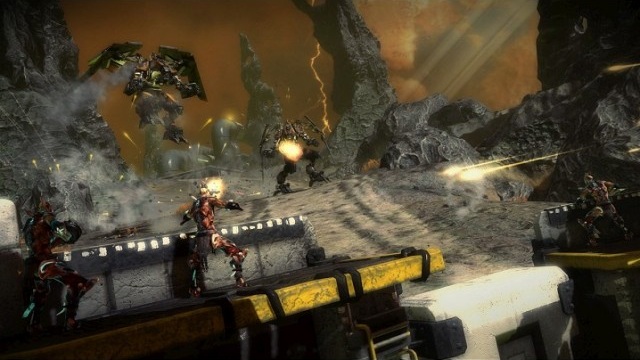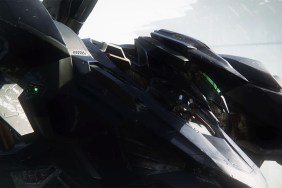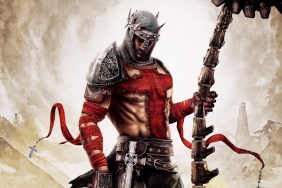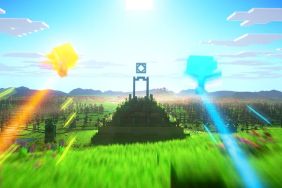A man called Steve.
Starhawk is the spiritual sequel to Warhawk which in many ways should tell you all you really need to know about the game. Though it has a campaign mode, it mostly serves as an extended tutorial on how to play the multiplayer game.
Set up in its single player, Starhawk's world is a space western with Rift energy taking the place of black gold. It's western-ness doesn't really match the coolness of Firefly so much as it's a cross between Bravestarr and the Jonah Hex movie trailer, crossed yet again with Halo. Rift energy is the currency you use to build tower defense-like battlements and vehicles, Starhawk's key gameplay element. Collect the rift energy you need, select an area, and the emplacement drops from outer space with a satisfying crunch.
Let's dispense with the campaign first. In Starhawk you play as generic gruff action hero Steve (his name is really Emmet Graves, but I call him Steve due to his bland game-hero-ness). A half-human, half rift-energy monster thing, you set about destroying the rift energy monster Outcasts as a mercenary, one of whom turns out to be a familial relation. Sheeit.
The campaign takes the player through control basics for the third-person shooter gameplay, the tower creation, and vehicular gameplay, with emphasis on the Hawks (the mechs). It clocked in around 6-7 hours, though in the penultimate level I spent too much time trying to salvage towers that would be swarmed to death when all I really had to do was rebuild them after they were destroyed. At a talk I attended at GDC, a developer talked about how good design makes you hate the villain of the game and bad design makes you hate the developer. As much as this game's villain is a boilerplate Darth Water with voodoo makeup, that is not what I hated.
Still, I must give props to Lightbox Interactive for having a black hero instead of a Marcus Fenix angry white man. It's nice to see a little diversity in a protagonist (who's not a hot Asian chick), as was noted by the impromptu Cinqo De Mayo partygoers who half-watched me play and half-watched YouTube videos of Japanese Bruce Willis. They also noted the ready comparison to Halo, with the Outcasts moving and acting like the Covenant, but were more Resistance Chimera-like in visual design.
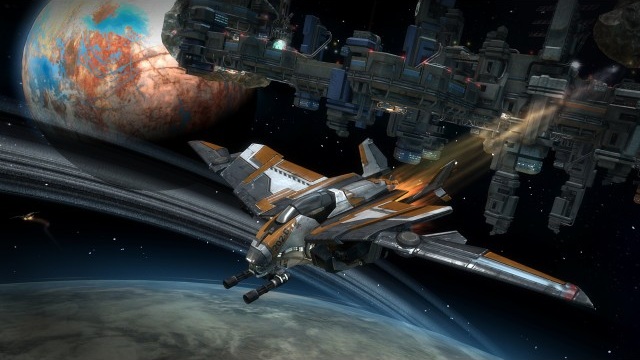
Starhawk is really all about its multiplayer, though, with large, looping maps with bases in opposite corners. The key feature of the base is the rift generator, which supplies steady pulses of rift energy to the player as long as they remain within a certain nearby area. As this builds up, the player can expend it on different defenses like linkable walls, weapon, and provision towers, and vehicles such as a Return of the Jedi-style speeder bike, Warthog-like jeep "Razorback", Halo-style Tank, and the Macross Valkyrie-like transforming Hawks. The towers can be built anywhere, but the rift energy does not naturally regenerate. The other way to get rift energy is to kill enemies.
Though a number of different game modes are available, including the Hawk-only Dogfight mode, the most prevalent seems to be Capture the Flag, for which the build-your-own base mechanic works extremely well. Managing the defenses versus offensive vehicle creation plays a huge part in the success of the game. While it's boring waiting near your rift generator to get enough energy to build one of the more choice defense towers (or a Hawk launch platform) can really help change the flow of the game.
The gameplay is clearly designed around the Hawks, though. The defenses, like the beam turret and the lock-on rocket launcher (available from a supply tower that must be built) exist to balance the Hawks' awesome firepower. The speed and ability of the Hawks make them one of the most exhilarating parts of the game, for both multiplayer and single-player. In one CTF game, my team's flag was stolen by a player racing away on a speeder bike and I chased him, flying low behind in a Hawk, strafing where he zipped along below rocky arches, before landing ahead of him to turn and blow him to a scattering of rift energy orbs. It was one of those action-movie moments that work so well in multiplayer games because they're so hard to choreograph in a single-player experience without being contrived.

Character progression is unlocked with skill-based challenges (kill ten enemies with a shotgun in a round, have ten allies use a vehicle station you built, etc.) that can be bought with points gained by leveling up. Experience is awarded for killing enemies, destroying enemy battlements, or completing game-based challenges (capturing or returning the flag, etc). This progression also unlocks character customization. The game has a co-op mode where the players must defend a rift generator from waves on enemies, but I was unable to play it with other players in time for the review.
I determine the strength of a multiplayer game by how much time players are willing to devote to it, and how it sucks them in and won't let go. For instance, when I played the demo for Mass Effect 3, I sat down to give the multiplayer a shot and found myself surprised that seven hours had passed while I'd been "casually" trying it out. For Starhawk, I found myself looking at my watch after two hours to see if I should give it more time to grow on me before I began to organize my thoughts about the review.
Starhawk is a solid multiplayer experience, though the vehicles and design are derivative, and fans of Warhawk will no doubt appreciate the build-your-own defense gameplay innovations. However, its workman-like tutorial "campaign" was short and bland and the multiplayer didn't "hook" me.
-
Exhilarating Hawk gameplay
-
Derivative other vehicle design
-
Tactical buildable defenses
-
Generic visual design
-
Skill-based leveling system
-
Lackluster "tutorial" campaign
